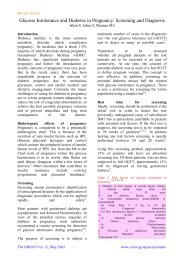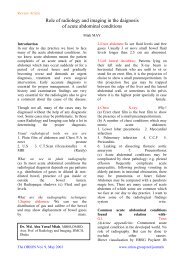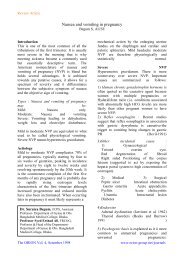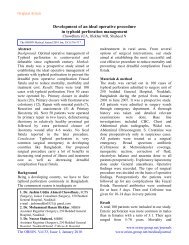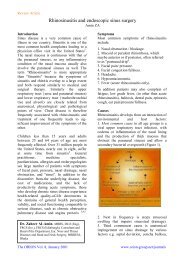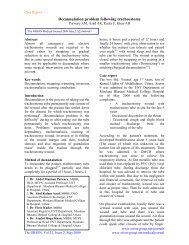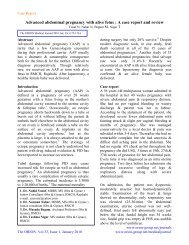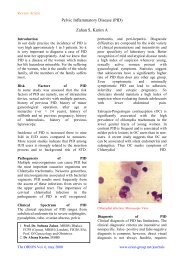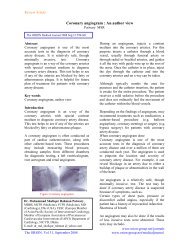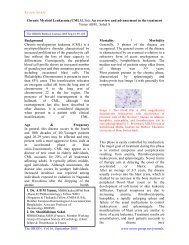An overview of infertility - Orion Group
An overview of infertility - Orion Group
An overview of infertility - Orion Group
Create successful ePaper yourself
Turn your PDF publications into a flip-book with our unique Google optimized e-Paper software.
Editorial<br />
<strong>An</strong> <strong>overview</strong> <strong>of</strong> <strong>infertility</strong><br />
Chowdhury TA, Chowdhury TS<br />
The ORION Medical Journal 2009 Jan; 32(1):610-611<br />
Infertility is a condition that causes<br />
considerable psychological distress to the<br />
couples. Even though the exact prevalence <strong>of</strong><br />
<strong>infertility</strong> in Bangladesh is difficult to<br />
ascertain, it affects 10 to 15% couples in the<br />
western world. 1 There has not been any major<br />
increase in the prevalence <strong>of</strong> <strong>infertility</strong> in<br />
recent years, but there is a greater awareness<br />
<strong>of</strong> the problem and also availability <strong>of</strong> more<br />
effective treatments like in vitro fertilization<br />
even in countries like Bangladesh.<br />
Epidemiological data indicate that conception<br />
occurs in 84% <strong>of</strong> women within 12 months<br />
and 92% by second year <strong>of</strong> ceasing<br />
contraception1. So <strong>infertility</strong> can be defined<br />
as inability to conceive after one or two years<br />
<strong>of</strong> regular unprotected sexual intercourse. It<br />
can be broadly divided into primary <strong>infertility</strong><br />
where couples have never conceived<br />
previously and secondary <strong>infertility</strong> where<br />
couples have had a pregnancy, although not<br />
necessary a successful one.<br />
Either the male and female partners can be<br />
responsible for <strong>infertility</strong> in around 30% cases<br />
or both are involved in another 25 to 30%<br />
cases. In the remaining 10 to 15% case, no<br />
cause could be found out, which is known as<br />
unexplained <strong>infertility</strong>.<br />
Semen analysis remains the most important<br />
aspect <strong>of</strong> male investigations. World Health<br />
Organization values for definition <strong>of</strong><br />
normality are widely accepted. 3 Additional<br />
investigations are required if semen report fail<br />
to meet these criteria. Serum FSH<br />
differentiates between obstructive and nonobstructive<br />
azoospermia and has enormous<br />
prognostic value if ICSI (intracytoplasmic<br />
sperm injection) is to be considered. Serum<br />
1. Pr<strong>of</strong>essor T. A. Chowdhury, FRCS, FRCOG,<br />
FRCP, FCPS (B) FCPS (P),<br />
Chief Consultant & Pr<strong>of</strong>essor <strong>of</strong> Obstetrics and<br />
Gynaecology, BIRDEM,<br />
2. Dr. Tanzeem Sabina Chowdhury, FCPS,<br />
MRCOG ,Junior Consultant, BIRDEM<br />
The ORION. Vol 32, Issue 1, January 2009<br />
testosterone is only indicated in suspected<br />
hypogonadism. Serum prolactin is suggested<br />
in men with coital difficulty. Semen culture is<br />
only required if there is microscopic evidence<br />
<strong>of</strong> infection.<br />
Investigations to find out the capacity <strong>of</strong><br />
sperm to fertilize an ovum are difficult to<br />
interpret. Even though post coital test is<br />
useful providing information about sperm<br />
function, systemic review <strong>of</strong> literature<br />
suggests that this test lacks validity for<br />
routine use.<br />
Significance <strong>of</strong> antisperm antibody present in<br />
serum or semen is unclear. It mostly develops<br />
following vasectomy or infections like<br />
epididymitis or orchitis. It is <strong>of</strong> clinical<br />
importance if reversal is required.<br />
Imaging <strong>of</strong> the male genital tract include<br />
thermography, Doppler USG or retrograde<br />
venography to diagnose varicocele. In<br />
obstructive azoospermia, vasography may be<br />
suggested in order to find out the site <strong>of</strong><br />
obstruction. Testicular biopsy has been<br />
virtually replaced by serum FSH estimation.<br />
About 15% azoospermic men are found to<br />
have abnormal karyotype like Klinefelter's<br />
syndrome. So karyotyping may be suggested<br />
in men with azoospermia or severe<br />
oligospermia.<br />
During management <strong>of</strong> male <strong>infertility</strong>, men<br />
should be advised to reduce alcohol intake,<br />
stop smoking and use or recreational drugs<br />
which interfere with fertility.<br />
There are various treatments for male<br />
<strong>infertility</strong>. Even though the WHO suggests<br />
that there is an inverse relationship between<br />
semen quality and the presence and severity<br />
<strong>of</strong> varicocele, at present there is no evidence<br />
that surgical treatment <strong>of</strong> clinically detectable<br />
varicocele with oligospermia improves<br />
www.orion-group.net/journals<br />
www.orion-group.net/medicaljournal
Editorial<br />
pregnancy outcome. Hypogonadotrophic<br />
hypogonadism in men can be successfully<br />
treated with exogenous gonadotrophin or<br />
GnRH therapy. Ejaculatory problems are<br />
<strong>of</strong>ten treated with alpha adrenergic and<br />
anticholenergic drugs.<br />
Acute bacterial infection <strong>of</strong> the genital tract<br />
should be treated with antibiotic even though<br />
there is no evidence that antibiotics improve<br />
male fertility. Epididymovasostomy is<br />
suggested in post vasectomy cases.<br />
Orchidopexy is suggested when ever there is<br />
testicular maldescent.<br />
There are various empirical treatments for<br />
male <strong>infertility</strong> which has not shown to be<br />
effective. There is no evidence to recommend<br />
gonadotropin, GnRh, testosterone, anti<br />
estrogens like clomiphen or tamoxifan in<br />
treatment <strong>of</strong> male <strong>infertility</strong>. Bromocriptine is<br />
only beneficial in men with hyper<br />
prolactenemia. <strong>An</strong>tioxidants like glutathione,<br />
vitamin E and C may improve semen<br />
parameters but this mode <strong>of</strong> treatment<br />
requires further evaluation. Systemic steroid<br />
therapy does not improve immunological<br />
male <strong>infertility</strong> and it is not recommended.<br />
Assisted reproduction has great role in male<br />
<strong>infertility</strong>. IUI (intrauterine insemination)<br />
improves the relative odds <strong>of</strong> pregnancy if<br />
semen parameters are abnormal, even though<br />
the pregnancy rates remain low (4-6%) 6.<br />
Men with severe sperm abnormalities or nonobstructive<br />
azoospermia now can be managed<br />
by microsurgical sperm retrieval with ICSI<br />
(Intra Cytoplasm Sperm Injection) but it puts<br />
the female under hazard <strong>of</strong> assisted<br />
reproduction.<br />
Regarding females, investigations are done to<br />
find out if the woman is ovulating. Laboratory<br />
evidence may be obtained through<br />
measurement <strong>of</strong> serum progesterone in the<br />
luteal phase <strong>of</strong> menstrual cycle. If there is<br />
history <strong>of</strong> irregular menstruation or periods <strong>of</strong><br />
amenorrhoea, especially associated with<br />
obesity, hirsuitism or galactorrhoea,<br />
additional biochemical tests like serum FSH,<br />
The ORION. Vol 32, Issue 1, January 2009<br />
LH, TSH and prolactin in early follicular<br />
phase should be done.<br />
When the preliminary investigations suggest<br />
that the woman is ovulating and sperm<br />
production is satisfactory, pelvic assessment<br />
should be undertaken. If there is identifiable<br />
risk factors for pelvic pathology like past<br />
history <strong>of</strong> pelvic inflammatory disease,<br />
previous ectopic pregnancy or symptoms<br />
suggestive <strong>of</strong> endometriosis, either<br />
hysterosalpingography or laparoscopy with<br />
dye hydrotubation is advised.<br />
Sonohysterography, an alternate outpatient<br />
investigation may be used as well but it has<br />
yet to gain widespread popularity.<br />
Treatment <strong>of</strong> ovulatory failure depends upon<br />
the cause. In WHO group I ovulatory<br />
dysfunction (due to hypothalamo pituitary<br />
failure), weight gain is the most effective<br />
treatment if there is significant weight loss.<br />
Use <strong>of</strong> pulsatile GnRh agonist is mainly<br />
indicated where endogenous GnRh levels are<br />
very low. In hyperprolactenemia, medical<br />
therapy including bromocriptine, cabergoline<br />
or quinigalide are most effective to reduce the<br />
prolactin level. Surgery is required when<br />
there is large macro adenoma.<br />
In type II ovulatory failure (mainly PCOS)<br />
treatment options include, weight loss and<br />
lifestyle modification. Insulin sensitizing<br />
agents like metformin reverse some <strong>of</strong> the<br />
metabolic effects <strong>of</strong> PCOS (Polycystic ovary<br />
syndrome) and act as pre-treatment and cotreatment<br />
agent with anti estrogens. 7<br />
Clomifene is most widely used anti estrogen.<br />
Multiple pregnancy can occur in around 7 to<br />
10% cases and mainly involves twins. OHSS<br />
(Ovarian hyper stimulation syndrome) is rare.<br />
A distant link with ovarian cancer has been<br />
described in women receiving more than 12<br />
cycles <strong>of</strong> clomifene, so it should be used to<br />
the lowest effective dose and duration <strong>of</strong> use.<br />
Gonadotropins (hMG, purified FSH,<br />
recombinant FSH) are used when patient fail<br />
to ovulate with clomiphen with or without<br />
metformin. Miscarriage rate is quite high (25-<br />
30%) in gonadotropin ovulation induction 6 .<br />
Multiple pregnancy rate is 15 to 20% and rate<br />
www.orion-group.net/journals<br />
www.orion-group.net/medicaljournal
Editorial<br />
<strong>of</strong> OHSS is 1-2%8. Recently aromatase<br />
inhibitors like letrozol are used in anovulatory<br />
women with PCOS who are resistant to<br />
clomifene but large randomized trials are<br />
required to investigate its effectiveness.<br />
Laparoscopic ovarian drilling is widely used<br />
now days. It results in mono follicular<br />
ovulation which means the risk <strong>of</strong> OHSS and<br />
multiple pregnancies can be avoided. It also<br />
increases ovarian sensitivity to subsequent<br />
treatment with clomifene. There has been no<br />
evidence <strong>of</strong> premature menopause for women<br />
followed up for over 10 years. 6<br />
Egg donation is the only treatment option for<br />
type III ovulatory failure (Ovarian failure).<br />
In case <strong>of</strong> <strong>infertility</strong> due to tubal cause,<br />
medical treatment has limited values.<br />
Chemotherapy has a definite role in cases <strong>of</strong><br />
tuberculosis even though it will not reverse<br />
the damage present. Surgery <strong>of</strong>fers the best<br />
results when carried out in properly selected<br />
cases. Salphingography with tubal<br />
catheterization or hyteroscopic tubal<br />
recanalization can be the treatment options.<br />
Compared to IVF (In vitro fertilization), tubal<br />
surgery carries no risk <strong>of</strong> OHSS and a lower<br />
risk <strong>of</strong> multiple pregnancies and miscarriage,<br />
even though ectopic pregnancy is a possible<br />
outcome with all surgical techniques. Most<br />
cases <strong>of</strong> tubal sterilization can be treated with<br />
tubal reanastomosis. IVF is the first-line<br />
treatment if there is moderate to severe tubal<br />
disease and should be discussed if pregnancy<br />
does not occur 12 to 18 months after surgery.<br />
Endometriosis is commonly associated with<br />
<strong>infertility</strong>. Medical treatment has no role in<br />
endometriosis related <strong>infertility</strong> 9 . Surgery is<br />
<strong>of</strong>ten the only treatment but in cases <strong>of</strong><br />
moderate and severe disease, assisted<br />
reproductive techniques should be considered<br />
as an alternative or after unsuccessful surgical<br />
treatment.<br />
Effective treatment <strong>of</strong> unexplained <strong>infertility</strong><br />
includes super ovulation and intrauterine<br />
insemination and in vitro fertilization. A Meta<br />
analysis has demonstrated statistically<br />
The ORION. Vol 32, Issue 1, January 2009<br />
significant benefit following treatment with<br />
clomifene in inexplained <strong>infertility</strong>. 10<br />
Significant developments have taken place in<br />
the field <strong>of</strong> assisted reproduction over the last<br />
15 years. IUI (intra uterine insemination)<br />
involves timed introduction <strong>of</strong> washed motile<br />
sperm into the uterine cavity. It is a relatively<br />
less invasive procedure which is considered in<br />
cases <strong>of</strong> mild male <strong>infertility</strong>, unexplained<br />
<strong>infertility</strong> and coital or ejaculatory failure.<br />
IVF is a method <strong>of</strong> assisted reproduction<br />
when the sperm and oocytes are mixed to<br />
allow fertilization to occur in vitro. The<br />
resulting embryos are then transferred into the<br />
uterus. Success rate <strong>of</strong> IVF has risen<br />
significantly during the course or last 10 years<br />
and have reached 28.8% live birth<br />
rate/embryo transfer for women under the age<br />
<strong>of</strong> 38 years and 24.3% for all age groups. 11<br />
Lastly the advent <strong>of</strong> ICSI (intracytoplasmic<br />
sperm injection) has revolutionized the<br />
management <strong>of</strong> couples suffering from severe<br />
male factor <strong>infertility</strong>.<br />
There has been a vast improvement in the<br />
management <strong>of</strong> <strong>infertility</strong> in the last 20 years.<br />
The rational use <strong>of</strong> different drugs, surgery<br />
and newer IVF techniques holds the promise<br />
<strong>of</strong> a solution for many infertile couples. But<br />
for clinicians, it is also a challenge to deploy<br />
these new techniques safely and effectively.<br />
So adequate evaluation must be done before<br />
they are used in routine clinical practice.<br />
References<br />
1. Te Velde ER, Eijkemans R, Habbema HDF.<br />
Variation in couple fecundity and time to<br />
pregnancy, an essential concept in human<br />
reproduction. Lancet 2000;1928-9.<br />
2. Hull MG, Glazener CM, Kelly HJ, Conway<br />
DI, Foster PA, Hinton RA, 1985. Population<br />
study <strong>of</strong> causes, treatment and outcome <strong>of</strong><br />
<strong>infertility</strong>. Br Med J 291,1693-97.<br />
3. World Health Organization (2000) WHO<br />
laboratory Manual for the examination <strong>of</strong><br />
human semen and<br />
sperm-Cervical<br />
interection.<br />
Cambridge:Cambridge University press.<br />
4. Oei SG, Helmerhost, FMOei SG,<br />
Helmerhost , FM Keirse M. When the post<br />
www.orion-group.net/journals<br />
www.orion-group.net/medicaljournal
Editorial<br />
coital test normal. A critical appraisal. Hum<br />
Reprod 1995;2:2-7.<br />
5. World Health Organization. The influence<br />
<strong>of</strong> varicocele on parameters <strong>of</strong> fertility in a<br />
large group <strong>of</strong> men presenting to the<br />
<strong>infertility</strong> clinics. Fertil Steril 1992;57:1289-<br />
93.<br />
6. Bhattacharya S, Hamilton M, Management<br />
<strong>of</strong> <strong>infertility</strong> for the MRCOG and<br />
beyond.2006;23-42:RCOG press.<br />
7. Lord MJ. Flight IHK, Norman R.<br />
Metformin in polycystic ovarian syndrome:<br />
systemic review and meta-analysis. BMJ<br />
2003;327, 951-6.<br />
8. Leven, Wild J, Steer p. Higher multiple<br />
births and the modern management <strong>of</strong><br />
<strong>infertility</strong> in Britain. The British association<br />
<strong>of</strong> Perinatal Medicine.Br J Obstet Gynaecol<br />
1992;99:507-13.<br />
9. Adamson GD, Pasta DJ. Surgical treatment<br />
<strong>of</strong> endometriosis-associated <strong>infertility</strong>:Meta<br />
analysis compared with survival analysis. Am<br />
J Obstet 1994;171:1488-504.<br />
10. Hughes E, Collins J, Vanderkove<br />
P.Clomiphene citrate vs. placebo or no<br />
treatment in unexplained <strong>infertility</strong>. Cochrane<br />
Database Sys Rev 1998;(2).<br />
11. National Collaborating Centre for<br />
womens and children's health.Fertility :<br />
Assesment and treatment for people with<br />
fertility Probelems. London:RCOG<br />
press;2004.<br />
The ORION. Vol 32, Issue 1, January 2009<br />
www.orion-group.net/journals<br />
www.orion-group.net/medicaljournal



